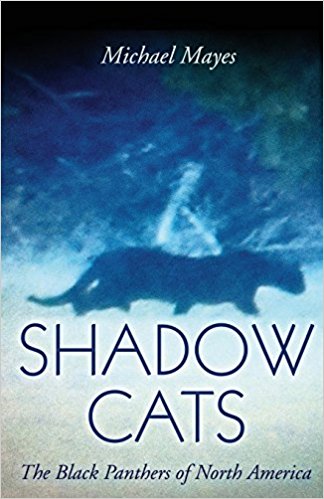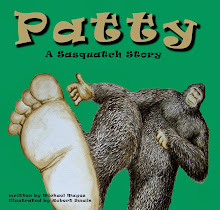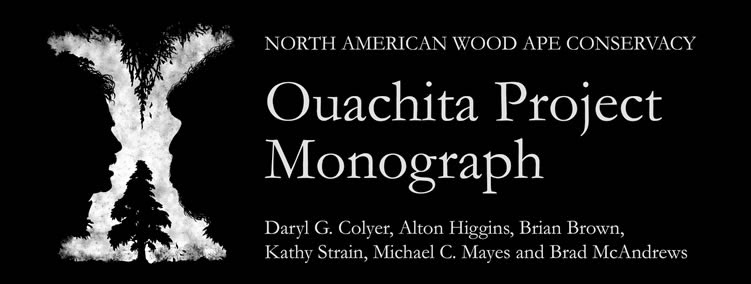 There are many tales of encounters with the sasquatch that have become almost mythic. These are the tales that I would refer to as the "classics." Many of these stories have been told and retold often through the years and appear in almost all books dealing with the subject of bigfoot. Other stories are less well known to the general public but are discussed often among those who seek these creatures. Some of the stories ring true and others I have serious doubts about. The stories of people who were allegedly abducted by a sasquatch and held against their will occupy a unique place in bigfoot lore. While there are not many reports of abductions there may be more than most modern researchers care to discuss. Foremost, among such reports is the strange tale of Albert Ostman. A lesser-known account of an attempted abduction involved a man named Bill Cole. The story I would like to discuss today is not as well known as the Ostman tale but probably better known than the Cole account. This is the story of Muchalat Harry.
There are many tales of encounters with the sasquatch that have become almost mythic. These are the tales that I would refer to as the "classics." Many of these stories have been told and retold often through the years and appear in almost all books dealing with the subject of bigfoot. Other stories are less well known to the general public but are discussed often among those who seek these creatures. Some of the stories ring true and others I have serious doubts about. The stories of people who were allegedly abducted by a sasquatch and held against their will occupy a unique place in bigfoot lore. While there are not many reports of abductions there may be more than most modern researchers care to discuss. Foremost, among such reports is the strange tale of Albert Ostman. A lesser-known account of an attempted abduction involved a man named Bill Cole. The story I would like to discuss today is not as well known as the Ostman tale but probably better known than the Cole account. This is the story of Muchalat Harry.The tale of Muchalat Harry was documented very well by one of the "Four Horsemen" of sasquatch research, Peter Byrne. Below is the story of Muchalat Harry in Byrne's own words:
According to the Indians, there was once a large number of Bigfoot living on Vancouver Island, a large island, 12,408 square miles in area, off the west coast of British Columbia. The Indians knew about them, feared them, and respected them, but granted that they were harmless. One of the Indians of the Nootka Tribe, who lived at Nootka in 1928, claims to have been carried off by them and held captive for some time.
The story, told to me by Father Anthony Terhaar of Mt. Angel Abbey in Oregon, is a curious one. Father Anthony, a much-loved missionary priest who traveled the west coast of Vancouver Island for many years, was living at Nootka at the time of the story and he knew Muchalat Harry very well. Muchalat Harry was a trapper and something of a rarity among his fellow tribesmen. He was, according to Father Anthony, a tough, fearless man, of excellent physique.
In the course of his trapping; he was wont to spend long weeks in the forest alone, something that the average Indian did not do in those days, The Indians of the coast were apparently a rather timid people and they seemed to regard the deep forest as the home and territory of the Bigfoot. When they went into the deep inland forest for any reason, they never went alone. Muchalat Harry was different from other Indians. He went in the forest alone and feared nothing.
Late one autumn Muchalat Harry set off for the woods, with his traps and camping gear. His plan was to set out a trap line and stay in the woods for several months. He headed for his favorite hunting area, the Conuma River, at the head of Tlupana Inlet. From Nootka he paddled his own canoe to the mouth of the Conuma. There he cached the canoe and headed upstream on foot. Approximately twelve miles upstream he made his base camp and, after building himself a lean-to, started to put out his trap line.
One night, while wrapped in his blankets and clad only in his underwear, he was suddenly picked up by a huge male Bigfoot and carried off into the hills. He was not carried very far, probably a distance of about two or three miles, at the most. When daylight came he was able to see that he was in a sort of camp, under a high rock shelf and surrounded by some twenty Bigfoot They were of all sexes and sizes. For some time, they stood around him and stared at him. The males to the front of the curious group females behind them and young ones to the rear. Muchalat Harry was frightened at first and his fear grew to terror when he noticed, he said, the large number of bones lying around the campsite. When he saw these he was convinced that the Bigfeet were going to eat him.
The Bigfeet did not harm him in any way. Occasionally one came forward and touched him, as if feeling him, and when they discovered that his "skin" was loose — it was in fact his woolen underwear — several came forward and pulled at it gently.
While they looked at him and examined him, Muchalat Harry sat with his back to the rock wall and did not move. He was cold and hungry, but his thoughts were only on escape. Some time in the late afternoon, curiosity on the part of the Bigfeet seemed to slacken and with most of the Bigfeet out of camp, probably food-gathering he thought, there came the opportunity that he needed. He leapt to his feet and ran for his life, never looking back. He ran downhill, toward where he guessed the river to be and sure enough, he soon came to his campsite. In what must have been blind panic he bypassed his camp and ran for twelve miles to where his canoe was cached at the mouth of the Conuma.
Father Anthony describes the story of Muchalat Harry’s arrival at Nootka as follows. It was probably three in the morning. He and his brother Benedictines were asleep and the village was quiet. Suddenly there was a series of wild cries from the waters of the inlet. Lights were lit and he and others hurried down to the water's edge. There, near-frozen and exhausted in his canoe, lay Muchalat Harry. He was barefoot and clad only in his wet and torn underwear and he had paddled his canoe through the winter night 45 miles from the mouth of the Conuma River.
Father Anthony and his companions carried the almost lifeless form up from the water's edge. It took three weeks to nurse Muchalat Harry back to sanity and good health. Father Anthony, who took him into his own care, did the nursing and he told me [Peter Byrne] that during the course of these three weeks, Muchalat Harry's hair turned to pure white.
The story of the kidnapping came out slowly. At first Muchalat Harry would talk to no one. Then he told Father Anthony what had happened and, later, others. When he was fully recovered to health he was asked when he planned to go back to collect his belongings, the camp equipment, his pots and pans, his trap line and above all, his rifle, at the lean-to on the Conuma. In 1928 a trap line and all of its pieces must have been worth a great deal to an island Indian. A rifle alone would be regarded as a highly prized possession. But Muchalat Harry never went back to the Conuma. Not only did he never return there; according to Father Anthony, he never left the settlement at Nootka, never went in the woods again for the rest of his life. He preferred to lose all of his valuables and probably hard-won possessions rather than risk another encounter with the Bigfeet.
Late in 1972 I had occasion to visit Vancouver Island. I was on a routine investigating trip and when I found myself at Nainimo, not too far by road from the west coast and the scene of Muchalat Harry's adventure, I drove there. I stopped in Gold River and obtained from the Royal Canadian Mounted Police some maps and instructions on how to get to the Conuma River area. Nowadays there is a logging road that runs all the way down to the mouth of the river, and one Sunday morning, with the logging trucks out of the way, I drove there and made camp on the Conuma. I spent several days there, walking the riverbed and exploring. I tried to make a rough determination of where Muchalat Harry might have had his lean-to and I found a place that offered a good campsite, twelve miles from the mouth of the river on the edge of a series of high bluffs. The salmon were running in the Conuma while I was there and all night long I could hear them splashing up the shallow waters of the river. In the morning black bear worked the river, getting the salmon that had come ashore in the night or had become tangled in the limbs of fallen trees that lay in the river. I counted six bears in several days.
The country was generally wild and deserted and the actual mouth of the Conuma, where it flowed into the salt waters of the inlet, was one of the most beautiful places I have ever seen. Some of the forest close to the river had been logged off, but the logging work had moved on west and while I was there it was quiet.
The days began with morning mists on the river and then warmed to the clear crispness of perfect autumn weather. Evenings were cool and damp and nights bright with starlight that provided almost enough light to read. I found no sign of Bigfoot on the Conuma, nor any sign of Muchalat Harry's trap line or lean-to. I hardly expected to find anything of the latter, after forty-odd years. But even though Muchalat Harry was long gone, the river and the forest remained unchanged, The splashing salmon, the cold, clear water of the Conuma, the moss-covered banks, the shallow pools in the forest that the Conuma drained, that were the breeding places of the salmon, the river birds, the plodding bears, the deep silent waters of the inlet, all were as they must have been forty years before, when Muchalat Harry cached his canoe and made his camp there.
The story of Muchalat Harry is not discussed much these days. Loren Coleman, in his book Bigfoot! The True Story of Apes in America, theorizes this may be due to two factors. First, the number of sasquatches reported by Harry, an amazing twenty of different genders, sizes, and ages, makes the account just too much for many to swallow. Second, the native origins of the story may have caused it to be mostly ignored in the years immediately after the incident allegedly occurred. Certainly, it is possible these factors were, and maybe still are, at play. My theory on why the story is not well known is simpler. It is due to what I call the "Silver Medal" factor. Allow me to explain. Typically, people do not remember who finished second in an athletic contest. You can probably recall the gold medal heroics of Olympians like Muhammad Ali, Jesse Owens, Mark Spitz, and Carl Lewis. More recently you may have watched Michael Phelps, Lindsey Vonn, and Shaun White win gold medals. Can anyone out there remember the names of the silver medalists? Probably not. It may be that Muchalat Harry's abduction tale has simply been deemed to be the second most interesting sasquatch abduction story behind Albert Ostman's account. In other words, Muchalat Harry gets the "silver medal" and, therefore, less attention.
I find the story fascinating. It is, of course, impossible for me to know if Harry was telling the truth about what happened to him in the wilderness near the Conuma River in the Autumn of 1928. What is not up for debate is that whatever happened changed Muchalat Harry forever. By all accounts, Harry was a fearless man who would spend weeks to months at a time in the forest alone. This, as was pointed out by Byrne, is in stark contrast to his fellow tribesmen at the time. If the missionary, Father Anthony Terhaar, is to be believed, Muchalat Harry's hair turned stark white over a period of only a few weeks and he never again entered the forest. Harry did not even go back to retrieve his rifle, trap line, and other possessions. The equipment Muchalat Harry left behind would have been worth quite a bit to an island Indian. The decision to leave it all in the woods indicates there was real fear in Harry.
There seems to be little doubt that the main players in the drama were real people. Father Anthony Terhaar was interviewed directly by Peter Byrne. Byrne seemed to have no doubt that Muchalat Harry had been a real person. While Harry was never interviewed by Byrne, his tale was well known among his fellow tribesmen who heard the story directly from his lips. Even had this not been the case it would seem Father Anthony Terhaar would have no reason to make up such a tale. Everything I've read about the good Father has been positive. He was respected and well thought of by those that knew him. Certainly, there was no financial incentive to share the story.
I believe something truly terrifying happened to the Nootka tribesman called Muchalat Harry. Whether the events played out exactly as described to Peter Byrne by Father Anthony Terhaar is something each person will have to decide for themselves. Many have a problem with the almost super human effort Muchalat Harry allegedly exerted to get away from the band of sasquatches. If the story is to be believed, he sprinted from two to three miles to the river near his camp site, then ran approximately twelve miles to the mouth of the river where he had cached his canoe, and then paddled forty-five miles back to his village. This is something a normal human could not have done according to many. I'm not so sure. Modern athletes today compete in "Iron Man" triathlons where they swim five miles or more, ride a bike for 100 miles, and then run a full twenty-six mile marathon. If this is within the realm of human ability then Muchalat Harry's escape seems possible. Byrne himself wrote that Harry was an exceptional physical specimen. When you add the fact that the man felt he was literally running for his life it seems more plausible. Fear and adrenaline are a powerful combination. It is no wonder it took three weeks of bed rest for Harry to recover from his ordeal.
Why a sasquatch would kidnap a human is another question all together. Was Muchalat Harry right? Did the sasquatches intend to make a meal of him? It seems unlikely. If that had been the intent why wouldn't the sasquatches have dispatched him once he was brought to their "camp?" Why would the males and most of the mature females leave him unattended if he were considered prey? Nourishment and calories are too precious in the wild to be treated so carelessly. Was Muchalat Harry merely a curiosity? Something along the lines of a sasquatch show and tell item? One can only speculate.
In any case, the tale of Muchalat Harry is, in my opinion, truly one of the sasquatch "classics." It is a story that is hard to believe in the light of day. Like many such tales, however, it gets a lot easier to believe when out in the woods alone at that certain time after the campfire has died out and dawn is still hours away.












No comments:
Post a Comment